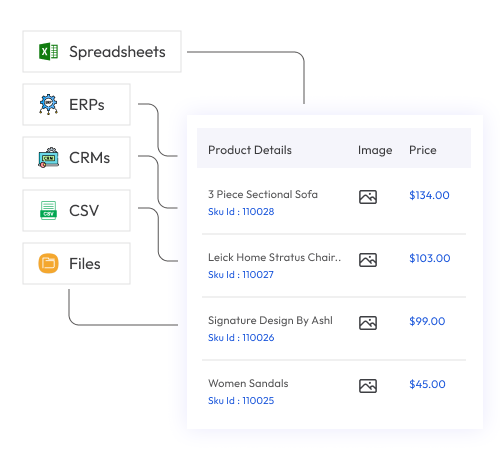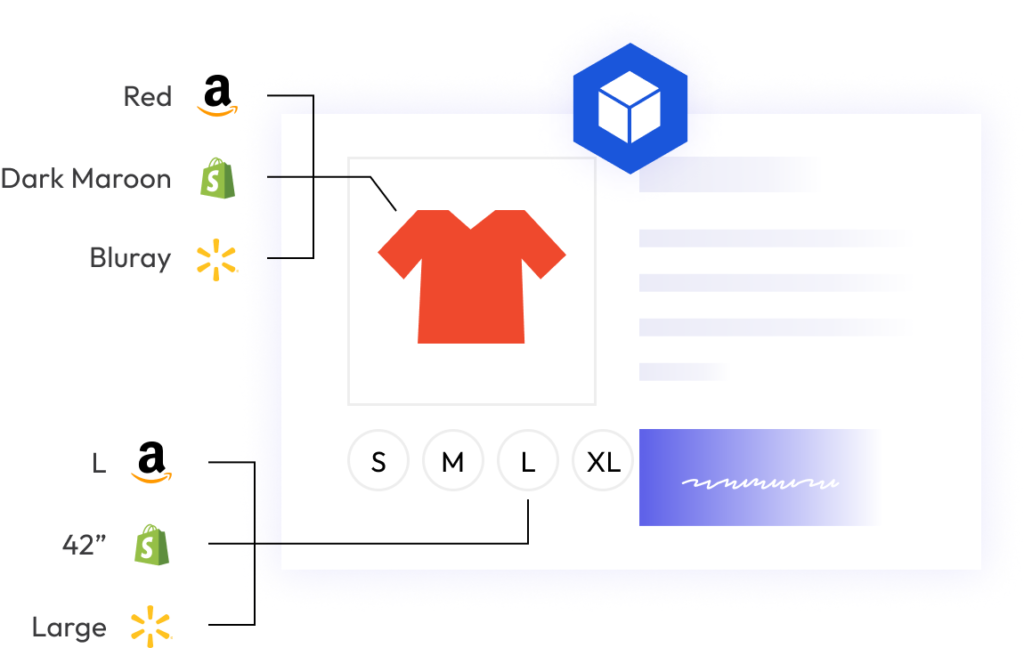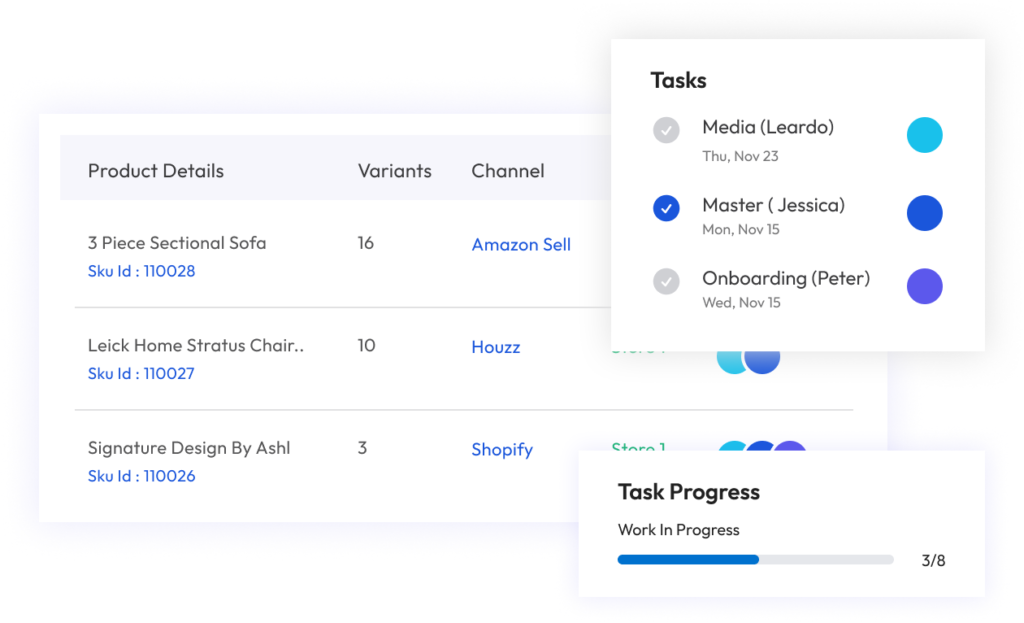Ever since online stores began to take over printed catalogs, a lot of businesses like Ikea decided to sunset the vintage glossy catalogs. This is because customers don’t have to wait for the publishing of physical catalog editions to drool over furniture pieces with coffee by their side or carry them around as a travel companion.

They can simply visit the Ikea website on their phone, and explore detailed product information. Unlike printed catalogs, digital product pages offer more than just well-shot images; they include videos, 3D models, and even VR experiences to visualize furniture in your space.
While Ikea stays modern, Amazon takes a nostalgic route with traditional holiday catalogs. The crucial point is that product pages, the feisty alter ego of physical catalogs, play a pivotal role in purchase decisions.
Creating an online catalog, unlike its printed counterpart, is complex. It compiles data from various sources, involves numerous data fields, and must comply with different channels.
This complexity is where PIM for eCommerce becomes indispensable.
What is eCommerce PIM?
An online business keeps a product catalog on a tight leash to ensure that the data is accurate, consistent, and complete and most importantly gives customers a good shopping experience.
While this is the objective of an eCommerce business, it is no small feat to get there. An eCommerce PIM helps streamline the journey of creating, managing, standardizing, enriching, and syndicating data, all from one platform.
Benefits of PIM for eCommerce
It is your product data HQ:
Imagine having to create product catalogs by referring to a bunch of files and folders. Running from one spreadsheet to another, scouring through files, digging through CRMs and ERPs, and finally putting together a catalog – only with many errors!
Without a PIM platform, online businesses would struggle to create and manage product information and ensure quality in published catalogs. A PIM platform acts as a single source of truth and makes it easy to manage product information.

Helps you create clean and consistent catalogs:
“Overall the web is pretty sloppy, but an online store can’t afford to be.” – Paul Graham, co-founder of startup accelerator Y Combinator.
Brand consistency and content accuracy are essential for your products as they directly impact reputation and revenue.
You cannot have different tones, styles, and content for each channel. For instance, a retailer selling fashion accessories may use a PIM system to ensure that product descriptions, images, and specifications are uniformly presented across their online store, mobile app, and printed catalogs.
This not only enhances the overall customer experience but also instills trust and reliability in the brand, as customers encounter a seamless and coherent representation of products, regardless of the platform.
Consistency also has another meaning in the world of e-commerce. For instance, a marketplace has certain norms and rules about the specifications or templates in which they present their products.
A PIM helps in maintaining that consistency so that your product content stays compliant with the channel requirements.

Enriches your product data for better engagement
In addition to maintaining consistency, PIM systems excel at enriching product data to drive better engagement. These systems allow businesses to include detailed and relevant information about each product, such as features, benefits, and usage scenarios.
For instance, an electronics manufacturer using a PIM system can easily update product specifications, include high-quality images, and attach user manuals to create a comprehensive and informative product listing.
This enriched data not only aids customers in making informed purchase decisions but also enhances search engine optimization (SEO) by providing search engines with valuable content to index. As a result, the products become more discoverable and attractive to potential customers, leading to increased engagement and, ultimately, higher conversion rates.

Helps you get to the market faster
One of the significant advantages of employing a PIM system is its ability to expedite time-to-market for new products.
For example, a consumer electronics company launching a new smartphone can use a PIM system to swiftly update product information, pricing, and marketing materials across various channels simultaneously.
This not only ensures a coordinated and coherent product launch but also enables businesses to respond quickly to market trends and consumer demands. By streamlining the process of updating and disseminating product information through native integrations of PIM with marketplaces and e-commerce platforms, it becomes easy to syndicate products in a snap.

Streamlines workflow management
PIM systems contribute significantly to the streamlined management of workflows within an organization. They provide a centralized platform where teams can collaborate on product data, ensuring that everyone is working with the most up-to-date and accurate information.
For example, a global retailer with multiple teams handling different product categories can use a PIM system to establish clear workflows for data creation, review, and approval.
This prevents bottlenecks, reduces the likelihood of errors, and enhances overall efficiency.
By optimizing workflow management, businesses can achieve a higher level of operational efficiency and bring products to market more smoothly.

Factors to consider when choosing a PIM for eCommerce business
Integrates with your existing tool stack:
A PIM system should seamlessly integrate with your existing technology stack, including your eCommerce platform, CRM, ERP, and any other essential tools. It should also integrate with the marketplaces and channels that you are using for seamless transfer of data.
Checks off all the basic features:
Ensure that the PIM solution covers fundamental features necessary for effective product data management. This includes support for product categorization, attribute management, version control, and multi-channel publishing. If your eCommerce business operates in multiple regions, the PIM should have localization capabilities to adapt product information for different markets
Helps enrich your data (beyond SSOT):
Look for a PIM system that goes beyond just maintaining a Single Source of Truth (SSOT) and offers tools for enriching product data. This could involve supporting multimedia assets etc.
Gives you a good ROI:
Evaluate the return on investment (ROI) potential of the PIM solution. Consider factors such as time saved on manual data entry, reduction in errors, and improvements in product discoverability and customer engagement. Choose a PIM system that aligns with your budget while delivering tangible benefits.
Supports with implementation:
Select a PIM provider that offers robust support during the implementation process. This includes comprehensive documentation, training resources, and responsive customer support
Top 5 PIM Tools for eCommerce Businesses
PIMworks:
A product information management platform that is industry-agnostic and serves businesses of all sizes. It helps e-commerce businesses solve product data challenges, improve time to market, and maintain product data quality and consistency.

Top features:
- Centralized storage
- Data syndication
- Data import and export
- Collaborative workflows
- Workflow management
- Automated content enrichment
- MAP monitoring
- Vendor onboarding
- Multiple vendor management
- SEO for product pages
- One-click integrations
- Digital asset management
- Localization and translation
- Category management
- Taxonomy management
- Analytics and insights
Pricing: Custom quote
2. Akeneo:
Akeneo helps medium-sized businesses and large enterprises manage product data and deliver consistent product experiences across channels. Akeneo helps e-commerce businesses achieve omnichannel experience through rich and consistent product catalogs.

Top features:
- Centralized product repository
- Data import and export
- Channel-specific data customization
- Versioning and history tracking
- Product enrichment
- Collaboration workflows
Pricing: Custom Quote
3. Pimcore:
With an open-source approach, Pimcore offers a comprehensive suite of PIM solutions, perfect for businesses seeking customization.

Top features:
- Digital Asset Management (DAM)
- Product Information Management (PIM)
- Multi-channel Publishing
- Workflow management
- Product data syndication
- Omnichannel publishing
- Data quality management
- Data Integration
Pricing: Custom Quote
4. Salsify:
Salsify focuses on enhancing the customer experience by providing tools for digital shelf optimization and real-time collaboration.

Top features:
- Centralized product data
- Onboard vendors
- Product data validation
- Workflow management
- Supplier experience management (SXM)
Pricing: Custom Quote
5. Plytix:
It serves small businesses and it has the main objective of helping online businesses end spreadsheet chaos.

Top features:
- Single source of truth for product data
- Product data syndication
- AI-generated product descriptions
- Digital asset management (DAM)
- Product sheets creation
Pricing: Starts at $499/mo
Final thoughts
Investing in a robust e-commerce PIM is not just a choice; it’s a strategic imperative. As the digital marketplace evolves, businesses that harness the power of PIM gain a competitive edge, ensuring their products shine brightly amidst the online retail landscape.
FAQs
PIM levels the playing field by offering small businesses the tools to manage and present their products with the same precision and efficiency as larger competitors.
Absolutely. PIM ensures consistency across various sales channels, providing a unified brand presence and improving the customer experience.
An intuitive interface, easy data input and retrieval, and collaborative features are key elements that make a PIM user-friendly for e-commerce teams.

